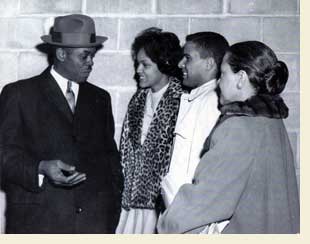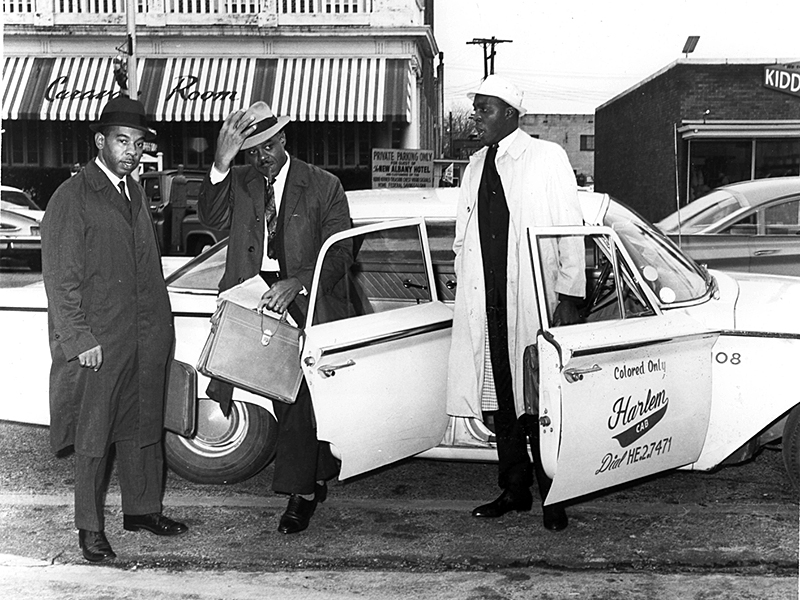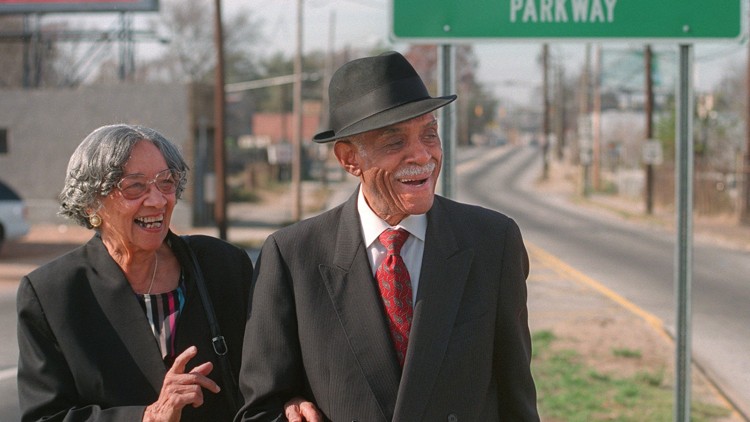From the NYT: [nyt] January 2005
ATLANTA, Jan. 1 – Donald L. Hollowell, a prominent Atlanta civil rights lawyer who played a part in a number of leading Georgia desegregation cases and later became an official of the Equal Employment Opportunity Commission, died here on Monday. He was 87.
The cause was heart failure, his family said.

[source]
His obituary in The Times is pretty stellar: joined the Buffalo Soldiers when he was told he’d have to quit school to make ends meet, served with some distinction in WWII earned a law degree from Loyola in Chicago, blah, blah. The Times is, as you’d expect from the mouthpiece of the establishment, a bit dry about Hollowell. Hollowell gained a view on racism when he was in the army, seeing how the army – and later the Jim Crow south – treated people. He concluded that black people in America were going to need lawyers, so he became one.
And lawyer, he did. He won a 1961 case against University of Georgia that resulted in the University finally admitting two black people (one man, one woman). He won the release of Martin Luther King, Jr., from Georgia State Prison – at a time when most of the civil rights movement expected King to be shot while trying to escape, or something like that. It was fairly clear from the way the prison authorities tried to move King around that they hoped to “lose” him somewhere where something bad could happen to him.

Hollowell and Jordan. Look at the door of the taxi. The US was such a disgusting place in 1960. Has it improved enough? No.
University of Georgia has a page [uga] about “unsung footsoldiers of the civil rights movement” but I’d sing him more as ‘heavy cavalry’. If you search about Hollowell on the web, there isn’t much, though Malcolm Gladwell does a pretty good bit on some of what Hollowell endured [rhp]. I’m not a big fan of Malcolm Gladwell but he does have his moments when he gets it right:
The two of them, Hollowell and Jordan, would drive around Georgia, from one end of the state to the next, to towns and courtrooms where a black lawyer was not just an anomaly, but a provocation.
Hollowell was subversive, in his own way, but also formal, proper. They used to say “He talked like a black Shakespeare.” Hollowell once paused in the middle of a trial, to instruct the court on the correct pronunciation of ‘Negro.’ Not ‘Nigrah’, your honor, but ‘Negro.’ Another time he was up against two district attorneys in court and the moment he got up to speak, the white judge swivelled in his chair, with his back to Hollowell, so he would not have to suffer the indignity of gazing upon a black man.
Of course Hollowell could not ask racist judges to recuse themselves from his cases; they were all racists in those days, in that state, of this deplorable country. Hollowell was not allowed to eat in the cafeteria at a courthouse; he and Jordan often went to grocery stores and bought bread and cheese and bratwurst, and ate sandwiches in Hollowell’s car – like migrant workers.
Back to Gladwell’s words:
Moore talks about arriving early at a hearing into the police shooting of a black teenager, to handle things before Hollowell got there.
“I got down to Deer County and to the courthouse, there were about 3,000 negroes on the steps. And I went into the courthouse and there were about 3,000 or as many as they could fit in the balcony upstairs. When I walked into the courtroom, the people upstairs, the black people, said “that ain’t Hollowell!” (laughs) “Where’s Hollowell?!” I had no idea what I was supposed to do, so I said well, I’ll act like Hollowell – I’ll just object in the loudest voice I can. And then people up in the balcony said, “Well, he ain’t Hollowell, but he’s sounds like Hollowell!” (laughs)
When Hollowell showed up at the court, he put the police officer on the stand. He’d shot a 17-year-old boy named Acey Hall. Hollowell took the officer through this testimony bit by meticulous bit, slowly exposing the officer’s lies. The cop was in tears by the end.
(Moore continues) “I’ve never seen that before or since, when a lawyer completely takes control of a witness and binds that witness to his will. Not with shouting and screaming, but with systematic, well-structured, well-placed questions.
Donald L. Hollowell does have a piece of highway named after him, outside of Atlanta. No Presidential Medal of Freedom for Hollowell. This country needs a bit less Robert E. Lee and a lot more Donald L. Hollowell.
I wouldn’t mind at all seeing a statue of Donald L. Hollowell.

I am not a “conspiracy theorist” but I’d be quite willing to bet a largeish stack of money against a smallish stack that elements of the US Government were behind King’s assassination. It’s not like they hadn’t been trying a bunch of tricks to get rid of him, already. And, when you compare Ray’s orderliness with Oswald’s, it’s always struck me as silly that conspiracy theorists see the CIA behind Kennedy and don’t even look at what an orderly well-run political hit looks like. [stderr] It looks like what happened to King: someone very deniable, willing to shrug and claim guilt, and do the time – along with some plea deals to avoid a death sentence. It was probably an emergent conspiracy: everyone in the state wanted King dead, Ray was just the filthy dirty trigger finger for the entire murderous civilization.
George Tenet was given a Presidential Medal of Freedom. Along with General Tommy Franks and L. Paul Bremer. Let that sink in.
A bit of bittersweetness: Hollowell’s widow of 61 years wrote the first book about him. Clearly he touched more than just my heart. Honor, always:

[mjac] (that’s Dr Louise Thornton Hollowell with him)

One of the cross-trails is named “Cherokee Trail” Fuck you, southerners. Really. Fuck you.

I’ll add a hearty fuck you. I have a post up this morning from Atlas Obscura, about the mass produced monument company which provided all those confederate statues. Reading about Mr. Hollowell (what a wonderful, kind face!), every single american should be stunned over the complete lack of statuary in regards to those who had stellar contributions to society, they just weren’t white.
Want statues? Great, have them. I have a handy list of candidates, many of them Indigenous, none of them white, and none of them the stupid, bigoted brand of the South.
The lady in the picture at the top has the same smile as the lady in the picture at the bottom. I can’t be sure, but she may be Louise.
Caine@#1:
Yeah, when I saw the “apache trail” bit I almost didn’t mention it because all I started to rageflail at my keyboard.
At this point I think the south needs some statues that look like a great big power fist with the middle finger sticking up. Edit: How about this for a memorial to the south’s “lost cause”? My photoshop skills aren’t really adequate but I think the message is clear. Maybe this could go in the park right across from “Confederate Hall”
Whoever is responsible probably breathed a sigh of relief, their due dilligence done, and checked the ‘Diversity’ box on their landmark list. Then they went back to the difficult task of chosing which tin traitor to stick up in which park.
Just kidding, there is no such thing as a diversity checkbox anywhere.
Regarding the proposed monument from #3:
How about the White House lawn?
Komarov:
:falls over laughing: Oh, I am so good with that, you just don’t know.
I sometimes wonder whether our whole tradition of monumental statues and honorary naming ought to just be put aside. It has a long history, but can we honestly say that it does any good anymore? I think this is a real and important question – should we use statues and names to honour people we think worthy of remembrance, like this Hollowell fellow, or should we abandon the practice altogether, given the ignominious history of who we have tended to render in bronze and marble over the centuries?
In some ways it seems wrong to afford a Hollowell the same honours that were afforded to Robert E Lee or Stalin or Richard the Lionheart or Nero. That’s not exactly the company he ought to be keeping.
Cartomancer:
So, best to keep the forgotten and oppressed that way, yes? I think, if you’re going to pose such a question, you pose it to those who have been victimised over the centuries by all those cast in marble,
bronze, and white zinc.I know you did not mean this, Cartomancer, but reading your ponder really hurt. Correcting injustices takes many forms. Currently, there are a lot of Indigenous people who would dearly like white people to give a shit about all the lousy monuments to Columbus, and would like those to come down too, but no one cares about that. Except us. We’d like a monument to an Indigenous person. No one cares about that, either. Except us. It’s always “you lost, get over it.” It’s always “can’t you just assimiliate?” It’s always “Columbus is really important to Italian people! And, y’know, you lost.”
cartomancer@#6:
I see where both you and Caine@#7 are coming from. I suppose it would be for the best if humans made statues to our virtues, or to great moments that will otherwise be lost in time.
Most of mankind’s statuary seems suspiciously filled with oligarchs on horses: war-causers, war profiteers, and red-fisted slaughterers. Often, it seems to me, that the statues are put up by their victims: the ‘victors’ of World War I, for example, who did such a good job of winning that they caused World War II.
There are some things I think deserve statues. As I’ve said elsewhere, Hachiko [wikipedia] probably deserves a statue, as an embodiment of the virtue of loyalty.
The Japanese appear to agree with me (obviously) and there is even a new statue of Hachiko, which is so sweet that it always gives me the sniffles. [new statue]
Great artists make their own memorials, which is where I believe the game is, really. I’d rather see statues to a kid’s gerbil, than to Winston Churchill or Ulysses Grant or Robert E. Lee. Even though I am a fan of Bonaparte’s military prowess, I’m a bit unimpressed with the grandeur of his tomb, compared to Voltaire’s.
In a sense, this piece on Hollowell is my way of saying that if anyone’s an avatar of justice, Hollowell is probably better than some abstract bronze woman who is blind and has wardrobe problems.
komarov@#4:
Regarding the proposed monument from #3:
How about the White House lawn?
You win the thread!
Monuments and statues are, on the whole, a good thing, at least in my mind. They can be very decorative and might make some nice historical artifacts one day. More importantly, they do remind people of history. They can be used to emphasise important events or bring things (events, people, …) out of obscurity when people tend to be unaware.*
You can put monuments up for specific individuals, groups, animals, events or concepts. But the meaning and context should be pretty clear. As long as its clear why a monument is here and what it is in (dis)honour of it should be (mostly) okay. (Please do correct me on this.)
For instance:
Confederate general with nothing but a name-plate in front of a major government building, not a good idea. No context. People have to fill in the blanks, which means they’re bound to get the wrong idea. The default association of monuments is, perhaps unfortunately, one with ‘greatness’.
But stick the same general in some less official place and add an appropriate plaque to it and it might just work. Appropriate, in this case, might be something among the lines of “This is [Name], a smegpot who defended slavery to the last breath of his men, then got off scott-free and retired to a grand estate. Because that’s how things worked back then apparently.”**
In that vein I really like the Hachiko statue. (The wiki-link is wrong, by the way) It’s more a statue to a virtue than the animal but evidently the two are so closely associated, so it works. Besides, it’s hard to imagine people misinterpreting a statue of a dog in the same way as they might that of a rebel general outside the town hall.
I’d definitely be in favour putting up monuments to indigenous people as Caine says, for the awareness-raising aspect of it. Maybe they could be made from melted-down Columbus statues? Or maybe, since you’re already remodelling, you could gather all the Columbi, the Confederates, Reagans or whoever, relabel them appropriately and collect them in a dedicated park. (“Embarrassment Park”, with mandatory school visits scheduled every year)
*A great example of how to do monuments are the “Stolpersteine” [wiki] in Germany. For close to three decades a man has been going around the country (and outside) and set small cobblestones into the pavement, with plaques showing the names and fates of those who were killed during the Holocaust. The stones are usually placed outside the homes where the victims used to live. It’s a reminder of both the national history as well as the local history behind these events. It shows how widespread the Nazi terror was and, quite literally, how close to home.
**Or consider a meta-plaque: “In [Year] some racist oaf decided to put up a grand statue in loving memory of this smegpot, who tried to destroy this oh-so-precious country of ours. We’re still living with the consequences of that war in part because of people like him.”
komarov@#10:
Maybe they could be made from melted-down Columbus statues?
A lot of statues were made from melted-down cannon.
(heavy forklift operator) “Why’s this statue of Hachiko so heavy?”
(city official) “Because it’s made of depleted uranium.”
(heavy forklift operator) “Oh. Uh…”
Caine, #7
I would certainly not want to say that the victims and oppressed be forgotten. Good lord no. I just wonder whether giving them the same treatment as the oppressors is the best way to remember them. Perhaps something more radical is needed that overturns the whole tradition and replaces it with something better (take down all the statues, problematic or not, and do something else for public memory instead). It seems to me that our whole language and culture of public statuary is perhaps too tainted, too wrapped up in the aesthetics of patriarchal imperialism, to deal with by modifying it rather than sweeping it away. In many ways it is a form of oppression in itself.
In the American context I would imagine this is particularly true. I don’t know whether any native cultures had their own comparable traditions of monumental statuary, before the consciously imperial Roman-derived traditions the colonists brought with them were introduced. If they did then perhaps those could be revived. I can understand and admire oppressed people’s desire to co-opt and transform the art and customs of the oppressors for their own edification and advancement – if that’s what is thought best then I wouldn’t want to interfere. It does seem something of a capitulation to colonial values, though. The normalisation of the idea that putting up a marble statue on a plinth in a park is somehow a human universal, rather than something Europeans do in conscious emulation of Roman conquest. Perhaps, on a practical level, it is the best way forward – the vast majority of the American population have internalised the custom, so modifying it to honour other people and other values is achievable.
But I still think the more radical critique of the system itself is valuable. I think we need an analysis that goes beyond “this is a good statue, that is a bad statue”, and recognises that the whole custom is slightly problematic. Even in mainstream European culture we tend to put up statues because it occurs to us as a default setting, rather than because we put much thought into the act.
Here’s something that seems obvious to me, but I haven’t seen stated this way. I’ve read plenty of articles like the above, of the form “If you want to memorialize greatness, then you should erect a statue of [choose one of a long list of forgotten heroes]”. Which, since it is true, means the contrapositive is also true: If the people you choose to represent your culture are those who fought a treasonous war to protect the right to own slaves, then you aren’t memorializing greatness. Which generalizes to “If those are the only people you can think of to represent your culture, then your culture sucks.”
I mean really, are treasonous oath-breaking slave-defenders the only people that represent Southern heritage? That’s honestly all you’ve got? Maybe history has already been erased. (And by “maybe” I mean “helooooo“.)
Johnny Vector@#13:
“If those are the only people you can think of to represent your culture, then your culture sucks.”
QFT
That map is where I spent much of my childhood. Stone mountain, at least when I was living there, was full of memorials and remembrances of the confederate “heroes”. You see Venable St. at the bottom of that map? From Wikipedia: “Stone Mountain was once owned by the Venable Brothers and was the site of the founding of the second Ku Klux Klan in 1915.” A few descendants of that family were still around and proud of that history and their families role in the Klan, when I lived there in the 80s. We are a despicable country indeed when we honor such people.